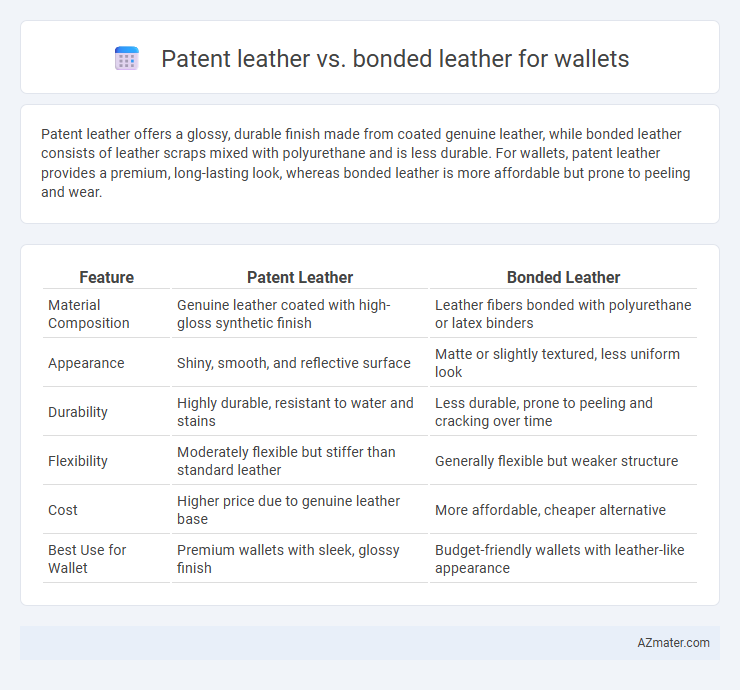Patent leather offers a glossy, durable finish made from coated genuine leather, while bonded leather consists of leather scraps mixed with polyurethane and is less durable. For wallets, patent leather provides a premium, long-lasting look, whereas bonded leather is more affordable but prone to peeling and wear.
Table of Comparison
| Feature | Patent Leather | Bonded Leather |
|---|---|---|
| Material Composition | Genuine leather coated with high-gloss synthetic finish | Leather fibers bonded with polyurethane or latex binders |
| Appearance | Shiny, smooth, and reflective surface | Matte or slightly textured, less uniform look |
| Durability | Highly durable, resistant to water and stains | Less durable, prone to peeling and cracking over time |
| Flexibility | Moderately flexible but stiffer than standard leather | Generally flexible but weaker structure |
| Cost | Higher price due to genuine leather base | More affordable, cheaper alternative |
| Best Use for Wallet | Premium wallets with sleek, glossy finish | Budget-friendly wallets with leather-like appearance |
Introduction: Patent Leather vs Bonded Leather Wallets
Patent leather wallets feature a high-gloss finish achieved through a coating process that enhances durability and water resistance, making them ideal for stylish, long-lasting accessories. Bonded leather wallets are made from shredded leather fibers mixed with adhesives and polyurethane, offering a more affordable but less durable alternative with a distinctive texture. Choosing between patent leather and bonded leather wallets depends on priorities like budget, appearance, and longevity.
What is Patent Leather?
Patent leather is a type of leather that features a high-gloss, shiny finish achieved through a coating of lacquer or varnish, making it highly reflective and smooth. It is typically crafted from natural leather that has been treated to enhance durability and aesthetic appeal, commonly used in fashion accessories like wallets for its sleek and polished look. Unlike bonded leather, which is made from shredded leather scraps bonded with polyurethane, patent leather is valued for its genuine leather base and distinctive glossy surface.
What is Bonded Leather?
Bonded leather is a material made from shredded genuine leather fibers mixed with polyurethane or latex, pressed onto a fiber or paper backing to create a leather-like surface. It offers an affordable and eco-friendly alternative to full-grain leather, often used in wallets for its smooth texture and uniform appearance. Compared to patent leather, which is coated with a glossy finish, bonded leather lacks the high shine but provides a softer, more flexible feel suitable for budget-conscious consumers seeking leather aesthetics.
Appearance and Aesthetic Differences
Patent leather boasts a glossy, mirror-like finish that gives wallets a sleek, high-shine appearance, making them stand out with a polished, luxurious aesthetic. Bonded leather exhibits a more textured, matte surface created from leather scraps bonded together, offering a rugged, natural look but lacking the refined gloss of patent leather. The distinct visual qualities of patent leather make wallets more formal and eye-catching, while bonded leather wallets tend to appear casual, with a softer, more muted tone.
Durability and Longevity
Patent leather offers a glossy, highly durable surface resistant to water and scratches, making it ideal for long-lasting wallets that maintain their shine over time. Bonded leather, composed of leather scraps fused with polyurethane, tends to wear out faster, showing cracks and peeling with frequent use due to its lower durability. For wallet longevity, patent leather is superior, providing enhanced resistance to daily wear and preserving aesthetic appeal.
Maintenance and Care Requirements
Patent leather requires careful maintenance to preserve its glossy, smooth surface, needing gentle cleaning with a damp cloth and occasional polishing to prevent cracks and maintain shine. Bonded leather demands less intensive care but benefits from regular dusting and conditioning with leather-specific products to avoid peeling and brittleness over time. Both materials should be kept away from direct sunlight and excessive moisture to extend the lifespan of wallets.
Cost Comparison
Patent leather wallets typically cost more due to the high-quality finishing process involving a glossy coating, which increases production expenses. Bonded leather wallets are more affordable as they are made from leather scraps bonded together with adhesives, reducing material costs significantly. The cost difference can range from 20% to 50%, making bonded leather a budget-friendly alternative without the premium appearance of patent leather.
Environmental Impact and Sustainability
Patent leather wallets, made from natural leather coated with a high-gloss finish, have a longer lifespan and are often more durable, reducing the need for frequent replacement and lowering environmental impact. Bonded leather, composed of shredded leather fibers bonded with synthetic materials, typically has a shorter lifespan and is less recyclable, contributing to greater waste and environmental strain. Choosing patent leather supports sustainability by promoting durability and reducing synthetic waste, whereas bonded leather often involves synthetic adhesives and chemicals that hinder biodegradability.
Ideal Uses and User Preferences
Patent leather, known for its glossy finish and durability, suits wallet users who prefer a stylish, eye-catching accessory ideal for formal occasions or everyday elegance. Bonded leather, made from leather scraps bonded with polyurethane, appeals to budget-conscious consumers seeking an affordable, eco-friendly wallet option with a more matte texture suitable for casual or frequent use. Users valuing longevity and a polished look typically choose patent leather, while those prioritizing cost and sustainability lean toward bonded leather wallets.
Conclusion: Choosing the Best Leather for Your Wallet
Patent leather offers a glossy finish and high durability ideal for wallets that require a polished, long-lasting appearance. Bonded leather, made from shredded leather fibers glued together, provides an affordable alternative with less durability and a synthetic feel. For wallets balancing elegance and lifespan, patent leather is the superior choice, while bonded leather suits budget-conscious buyers seeking style over longevity.

Infographic: Patent leather vs Bonded leather for Wallet
 azmater.com
azmater.com